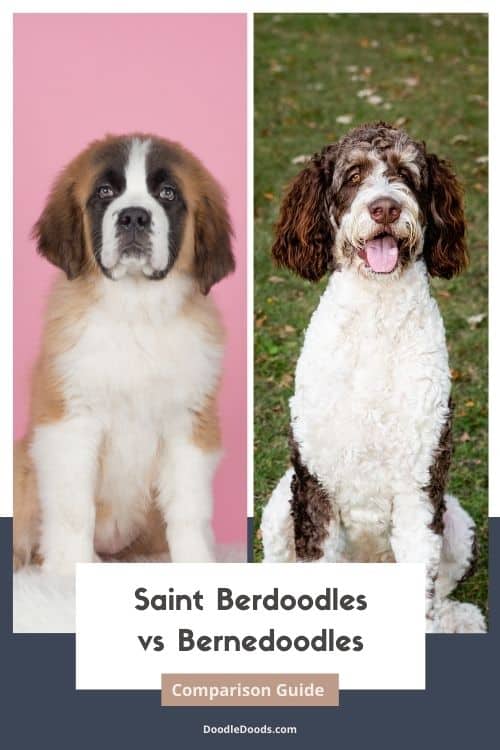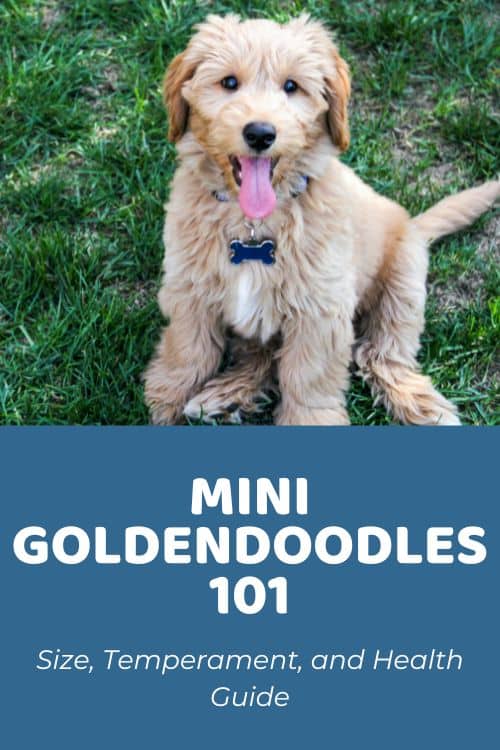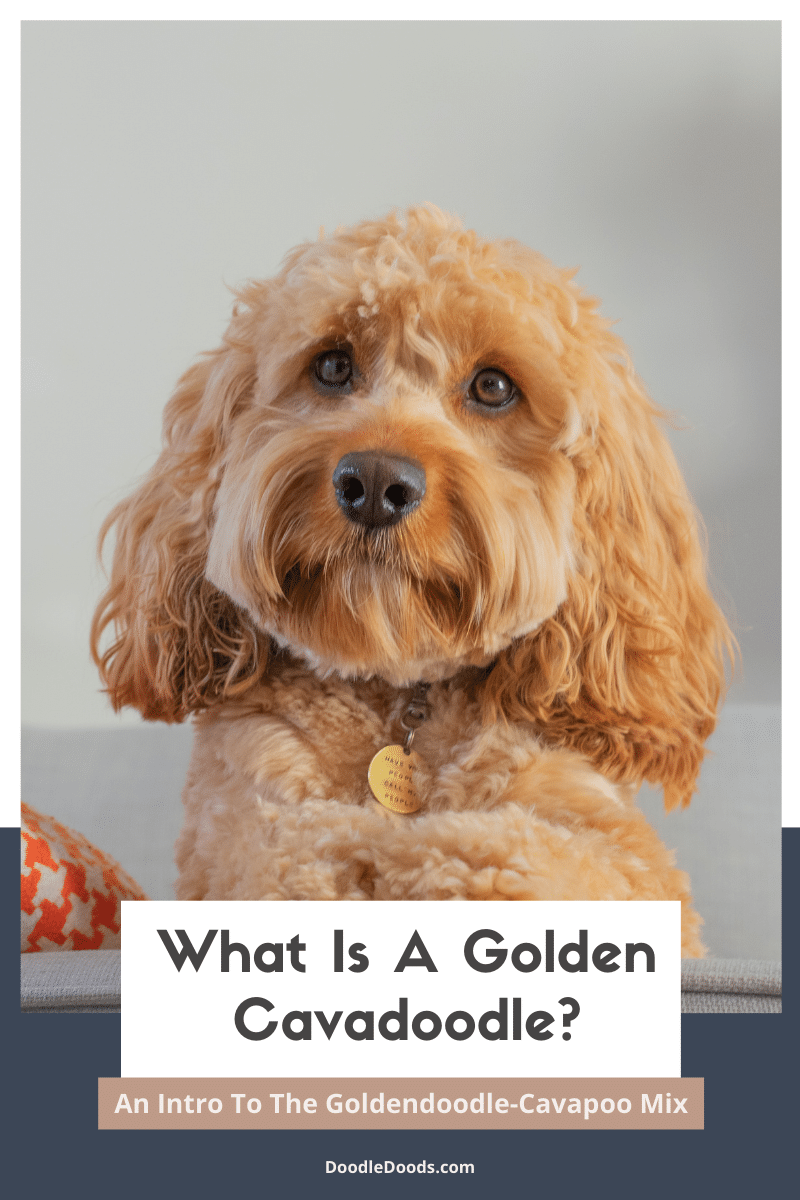Have you heard of the Irish Wolfadoodle? Perhaps you’ve encountered this wolf-sized Dood on your daily outings. Or maybe you’re just keen on learning more about this interesting crossbreed. Whatever the case, this guide will answer any and all questions you might have about the Irish Wolfhound-Poodle mix. We’ll cover everything there is to know about them, including their appearance and size, coat care and grooming, training and exercise requirements, personality and temperament, and much more. Keep on reading to learn more!
Table of Contents
- What Is An Irish Wolfadoodle?
- Irish Wolfadoodle Physical Appearance
- Irish Wolfadoodle Pictures (Puppy & Adult)
- Irish Wolfadoodle Size: How Big Will A Irish Wolfadoodle Get?
- Variations & Generations
- Personality & Temperament
- Irish Wolfadoodle Health: Do Irish Wolfadoodles Have Health Problems?
- Irish Wolfadoodle Lifespan: How Long Do Irish Wolfadoodles Live?
- Exercise & Training Requirements
- Irish Wolfadoodle Coat Care & Grooming
- Where Can You Get Irish Wolfadoodle Puppies?
- Irish Wolfadoodle: FAQ
What Is An Irish Wolfadoodle?
The Irish Wolfadoodle, or Irish Wolfoodle, is a cross between the Irish Wolfhound and Standard Poodle. They’re large, loving, and loyal dogs that carry themselves with dignity and an innate sense of calmness.
The Irish Wolfhound-Poodle mix is not the most well-known Doodle breed out there, but they sure are becoming more and more popular thanks to the rise of all sorts of different Poodle mixes.
As with any Doodle hybrid, the Irish Wolfadoodle is the perfect balance of both of its purebred parents. In terms of their looks, they’re similar to their purebred Irish Wolfhound parents with their large and muscular stature. And their Poodle heritage gives them that signature shaggy look of a true Doodle, paired with a low-shedding, allergy-friendly coat.
With one of the Irish Wolfadoodle’s parents being one of the oldest dog breeds – the Irish Wolfhound, also known as the Apollo of dogs – and the other being the cheeky and intelligent, curly-coated Poodle, we’re honestly a bit surprised that the Irish Wolfadoodle is still somewhat of a rarity crossbreed! But we’re here to fix this issue.
Irish Wolfadoodle Physical Appearance
The Irish Wolfadoodle is a large Doodle breed with an athletic build. They’re usually tall dogs with long, lean legs. Irish Wolfadoodles often have shaggy, thick, and fluffy coats that can range from curly to wavy to straight. Meanwhile, their face resembles much of the purebred Irish Wolfadoodle with a long muzzle.
Colors
Irish Wolfadoodles can inherit a wide variety of coat colors from their parents. Some of the most common colors seen in Irish Wolfadoodles are black, gray, blue, silver, red, cream, and white. Some Irish Wolfadoodles also have patterned coats like brindle, wheaten, and have different-colored markings on them, too.
Coat, Shedding, & Hypoallergenic Level
Irish Wolfadoodles come in three distinct coat types – curly, wavy, or straight. The purebred Poodle has a very curly, hypoallergenic coat, whereas the Irish Wolfhound has a straight double coat. When it comes to their Irish Wolfadoodle offspring, it all depends on what they inherit from each side of their lineage.
Even though Poodle mixes are often praised as hypoallergenic dogs, that’s not always the case. Indeed, some Irish Wolfadoodles are excellent for people with allergies, whereas others might not be the best choice, even with their Poodle genes in the mix.
Curly-coated Irish Wolfadoodles usually have a single layer of fur, which means that they take most after their Poodle parent. This also makes them the most hypoallergenic of them all. On the other hand, curly-coated Doods are the most prone to matting. This means that they also require the most upkeep.

Then there’s the wavy coat that’s somewhere in between the curly and straight coats. Some of these Doods may come with a lightly shedding undercoat, but not necessarily. The great thing about wavy-coated Irish Wolfadoodles is that they’re easier to groom and keep mat-free than curly coats.

Lastly, some Irish Wolfadoodles may also inherit the straight coat that resembles more the purebred Irish Wolfhound’s coat type. These dogs tend to have a shedding undercoat that requires regular brushing to keep that shedding to a minimum. For this reason, straight-coated Irish Wolfadoodles aren’t the best option if you struggle with severe allergies.
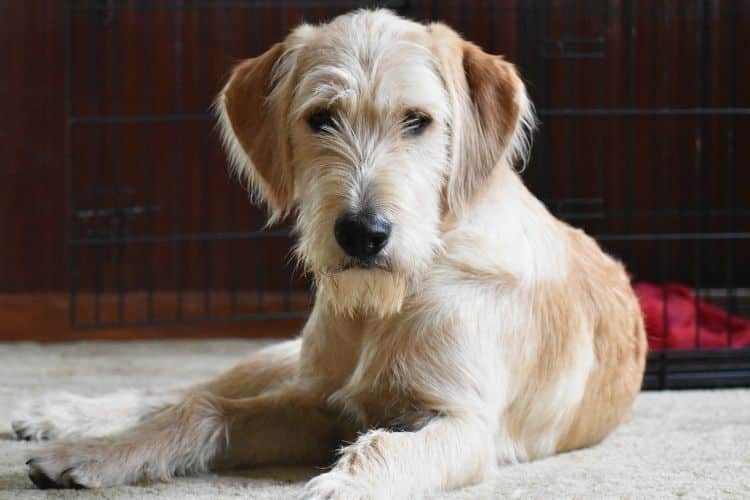
Irish Wolfadoodle Pictures (Puppy & Adult)
Are you prepared to see how cute the Irish Wolfadoodle really is? Here are some adorable pups for you to fall head over heels in love with:
| Gray Irish Wolfadoodle | @havok_the_irish_wolfadoodle |
| Black and White Irish Wolfadoodle | @olive_wolfadoodle |
Irish Wolfadoodle Size: How Big Will A Irish Wolfadoodle Get?
The Irish Wolfadoodle is a large dog with its average weight ranging between 70 and 120 pounds when fully grown. Their height is about 24 to 33 inches when measured from the shoulder.
| Standard Irish Wolfadoodle | |
| Weight | 70-120 pounds |
| Height | 24-33 inches |
| When Full-Grown? | 12.5-24 months |
*A dog’s height is measured from their withers, which is the highest part of their shoulder blades.
The Irish Wolfhound-Poodle mix is usually created with the Standard Poodle. That’s because the Irish Wolfhound is one of the largest breeds out there. Some of those dogs can weigh up to a whopping 180 pounds as adults!
Although Poodles come in three size categories (Standard, Miniature, and Toy), it’s extremely rare to come across a smaller Mini Irish Wolfadoodle. Keeping in mind that even the largest Standard Poodle with a weight of around 38 to 70 pounds is considerably smaller than the Irish Wolfhound, for the sake of consistency Irish Wolfadoodles are generally bred with larger Standard Poodles. Once this hybrid cross becomes more well-known, we might be able to see more Mini Irish Wolfadoodles emerging as well! But for now, Irish Wolfadoodles are certainly one of the largest Poodle mixes out there.
Variations & Generations
With hybrid breeds, the breeding process isn’t as straightforward as with purebreds. There are actually multiple ways how a breeder can produce a litter of Irish Wolfadoodles. And, with each generation there’s the possibility of achieving more control over the outcome. After all, we can never know for sure what we’re getting when crossing two very different purebreds! This will also help breeders strive for certain traits and characteristics. For instance, the puppies’ estimated adult size, coat type, shedding, and other traits.
Today, Irish Wolfadoodles are most commonly bred as first-generation, or F1 Irish Wolfadoodles. These pups are the direct offspring of a purebred Irish Wolfhound and a purebred Poodle. That’s simply because they’re such a new crossbreed. But again, as this Doodle breed becomes more well-known, we can expect to see more variations of them in the near future.
| 1st Parent | 2nd Parent | % Irish Wolfhound* | % Poodle* | |
| F1 Irish Wolfadoodle (first-generation) | Irish Wolfhound | Poodle | 50% | 50% |
| F1B Irish Wolfadoodle (first-generation backcross) | F1 Irish Wolfadoodle | Poodle | 25% | 75% |
| F1BB Irish Wolfadoodle (first-generation backcross backcross) | F1B Irish Wolfadoodle | Poodle | 12.5% | 87.5% |
| F2 Irish Wolfadoodle (second-generation) | F1 Irish Wolfadoodle | F1 Irish Wolfadoodle | 50% | 50% |
| F2B Irish Wolfadoodle (second-generation backcross) | F1 Irish Wolfadoodle | F1B Irish Wolfadoodle | 37.5% | 62.5% |
| F2B Irish Wolfadoodle (alternate cross) | F2 Irish Wolfadoodle | Poodle | 25% | 75% |
| F3 / Multigen Irish Wolfadoodle | F1B Irish Wolfadoodle or higher | F1B Irish Wolfadoodle or higher | Varies | Varies |
*These are generic calculations only – genetics are rarely mathematically accurate.

Personality & Temperament
Don’t let their appearance fool you! Irish Wolfadoodles are insanely loving and affectionate dogs that make gentle, intelligent, and friendly companions. They’re often described as noble and dignified, just like the purebred Irish Wolfhound. However, they do have a silly and playful side to them, too!
Irish Wolfadoodles are also relatively active dogs, which means that they love spending time on their feet and doing outdoorsy activities. Still, they tend to be very chilled and laid back dogs, especially if they’re getting enough exercise and mental stimulation throughout the day. They can also be quite vigilant, making sure to alert you whenever someone’s at the door or if they sense you’re in danger. Especially considering how loyal they are – these Doods will make sure that you and your family are safe!
Additionally, Irish Wolfadoodles are very patient dogs, making them excellent pets for people with children and other pets. Nonetheless, early socialization is crucial for them to learn how to properly interact with people, other dogs, and pets around them. But if you introduce your Doodle pup to plenty of people and other animals from a young age, you’ll have the sweetest, calmest companion by your side who doesn’t shy away from new interactions.
Keep in mind, however, that due to the Irish Wolfadoodle’s large size, they might seem intimidating to other people or even children and pets in your home. By no means are Irish Wolfadoodles aggressive, but they can accidentally knock over someone much smaller than them when they get a bit too excited during playtime. They may also get the urge to chase smaller animals, so you have to keep a close eye on your Dood whenever they’re spending time with kids or smaller pets.
Irish Wolfadoodle Health: Do Irish Wolfadoodles Have Health Problems?
Like any other breed or hybrid cross, Irish Wolfadoodles are at risk of some health conditions. These include joint problems like hip and elbow dysplasia as well as joint development issues that are common in large and giant breeds.
Irish Wolfadoodles are also at risk of a heart disease called dilated cardiomyopathy (DCM), and a dangerous condition called gastric dilatation volvulus (GDV), a.k.a bloat. They can also suffer from eye diseases like corneal dystrophy, progressive retinal atrophy (PRA), cataracts, and glaucoma. Like many other large breeds, they may also suffer from wobbler syndrome, which causes stiffness and lameness.
The great thing about the Irish Wolfhound-Poodle mix is that they’re actually somewhat healthier than their purebred parents. Crossbreeds benefit from hybrid vigor, which indicates that they tend to inherit superior genetics from both sides of their lineage, reducing the risk of common health conditions in their purebred parents.
There are also some minor conditions that Irish Wolfadoodles commonly are affected by, such as food allergies and sensitivities due to certain ingredients in their dry kibble or canned food. They may also develop allergies and sensitivities to their shampoos and conditioners, so you might have to opt for hypoallergenic shampoos to manage this issue.
And like most other Doodle breeds, Irish Wolfadoodles are also prone to ear infections. As their floppy ears restrict air flow, it’s not uncommon for bad bacteria to spread and lead to painful infections. This can be prevented with proper ear hygiene routine and by cleaning your dog’s ears after swimming and bathing.
Irish Wolfadoodle Lifespan: How Long Do Irish Wolfadoodles Live?
Irish Wolfadoodles have an average life expectancy of about 8 to 12 years. That’s quite a few extra years compared to the purebred Irish Wolfhound whose average lifespan ranges between 6 and 10 years.
Even though larger dogs like the Irish Wolfadoodle don’t have the longest life expectancy, there are still some simple steps you can take to ensure your Dood lives a long, healthy, and fulfilled life.
Firstly, if you’re planning to adopt an Irish Wolfadoodle puppy from a breeder, carefully study the breeding programs and make sure that you’re getting your puppy from an ethical breeder that only produces litters from extensively health screened and DNA tested parents. This will greatly minimize the chance of the puppies inheriting any major, life altering genetic illnesses.
Secondly, the environment and lifestyle you provide for your pup will also go a long way in maintaining their optimal health. Feeding the right amount of high-quality dog food, making sure your dog gets plenty of exercise daily, and preventing any unnecessary stress will benefit your dog’s health and longevity a great deal.
Exercise & Training Requirements
Irish Wolfadoodles are somewhat energetic dogs and they require about 60 to 90 minutes of exercise each day. The exercises don’t have to be too vigorous. Daily walkies can be perfectly enough for them. But if they inherit more of their traits from the Poodle, they’ll probably benefit from more activities throughout the day.
In addition to physical exercise, these Doods also need plenty of mental stimulation throughout the day to prevent boredom. When it comes to boredom and dogs, this usually manifests as unwanted and destructive behaviors, such as excessive barking, digging, or even damaging your home and furniture. Daily training sessions, interactive games, chew toys, and puzzle toys are all great ways to stimulate an Irish Wolfadoodle.
Speaking of which, Irish Wolfadoodles are very intelligent dogs. This means that they’re generally easy to train. On the other hand, they may sometimes be a bit stubborn, which can make the process a bit more time consuming than you’d like. Fortunately, they respond very well to positive reinforcement training methods. So make sure to stay consistent, patient, and give your pup plenty of praise and tasty treats during their training sessions.
The key to successfully raising a puppy into a well-rounded adult is to start as early as possible. From the moment you bring your new pup home, introduce them to their daily schedule and immediately start with potty training, crate training, and obedience training. Not only will this enforce good behaviors from an early age, making them much more likely to stick later on, it’ll also give a new puppy a sense of safety and security in a new, unfamiliar environment.
Online Puppy School by Baxter & Bella
Regardless if you’re an experienced or a novice dog owner, training and raising a dog can be tricky and sometimes even frustrating. To make the whole process a whole lot easier, you might want to get some extra help from true professionals in the field.
Our favorite pick for Doodles is the Online Puppy School by Baxter & Bella that has countless resources on all things related to dog and puppy training. They cover everything from the basics like potty training and leash walking, and they also have lots of resources on behavioral issues and how to fix them. Definitely worth checking out!
Irish Wolfadoodle Coat Care & Grooming
Like other Doodle breeds, Irish Wolfadoodles need to be groomed regularly to prevent matting and other coat and skin health issues. They need to be brushed and bathed, and you also need to get your dog’s hair trimmed on a regular basis.
Although some might claim that Irish Wolfadoodles are hypoallergenic dogs that don’t shed, that’s not necessarily the case with all pups. As we discussed earlier, their coat type can greatly affect how much they shed and also how allergy-friendly they are.
Regardless of your Irish Wolfadoodle’s coat type, you should brush them daily to prevent matting and shedding. To be more precise, for curly-coated Doods daily brushing is vital to prevent matted fur. Meanwhile, wavy and straight-coated Irish Wolfadoodles will shed considerably less if you brush them every day. If you’re looking for some great dog brush recommendations, here we have picked out the perfect options for Irish Wolfadoodles.
Hair trimming is another important topic for Irish Wolfadoodles, as their hair can grow very long over a few months. The usual recommendation is to have your Doodle’s hair cut every 6 to 8 weeks. You can also learn how to do this yourself with the help of our online course How To Groom A Doodle At Home.
In addition to that, make sure to bathe your dog when they get dirty or smelly with a specially formulated dog shampoo. Some dog owners need to bathe their dogs every week, whereas others notice that their dogs only need to be washed when they get their hair trimmed. It all depends on your dog’s lifestyle and skin condition.
You should also aim to trim your dog’s nails and clean their ears with a dog ear cleaner about once a week. At least a few times a week, ideally every day, you should also brush your Doodle’s teeth with a dog toothpaste to prevent dental problems.
Where Can You Get Irish Wolfadoodle Puppies?
If you’re thinking about adopting an Irish Wolfadoodle puppy, make sure to do your research and only consider getting your puppy from a reputable breeder that follows ethical breeding practices. To help you out on your search, we created our very own Doodle Breeder Directory where we list reputable Doodle breeders all across the US. We also recommend you educate yourself on how to spot Doodle scammers and puppy mills before making any life-changing decisions.
But how much does an Irish Wolfadoodle cost to adopt? In the US, you can generally expect to pay around $1,500 to $4,000 for an Irish Wolfadoodle puppy. The exact price will depend on your location, but also the breeder’s reputation and experience. Understandably, the cost of a Doodle puppy is not cheap, but it does reflect everything that goes into building an ethical breeding program. Starting from health and DNA testing to providing the puppies and breeding dogs a safe and nurturing home environment, finishing with training and socialization techniques that will set your new puppy up for success.
Irish Wolfadoodle: FAQ
Irish Wolfadoodle combines the best traits from the purebred Irish Wolfhound and the Poodle. They’re very loving, calm, intelligent, and patient dogs that make great pets for many different households. Thanks to their Poodle heritage, they’re also excellent companions for people who struggle with allergies. Or, for those who simply prefer a dog that doesn’t shed as much as the purebred Irish Wolfhound.
Irish Wolfadoodles aren’t known to be big barkers. However, if their Poodle genes are more dominant, they might like to vocalize their wants and needs with you. But regardless of a dog’s breed, they might develop a habit of excessive barking from time to time. A simple trick is to make sure that your dog gets plenty of exercise and mental stimulation throughout the day to curb this issue. If it’s a bigger problem, more advanced training and desensitization techniques might be necessary.
Due to its large size, the Irish Wolfadoodle is best for someone who lives in a larger, more spacious home. Ideally with a large fenced backyard for your dog to romp around and play in. Thanks to their affectionate and sweet nature, and the ability to stay calm and patient, Irish Wolfadoodles also make great pets for families with children. However, make sure to keep a close eye on your dog’s interactions with small children since they are very, very large dogs. Similarly, these Doods may get the urge to hunt and chase smaller pets in the household. If you have smaller dogs or cats in your family, be sure to monitor their interactions at all times.
Want to Learn
DIY Doodle Grooming?
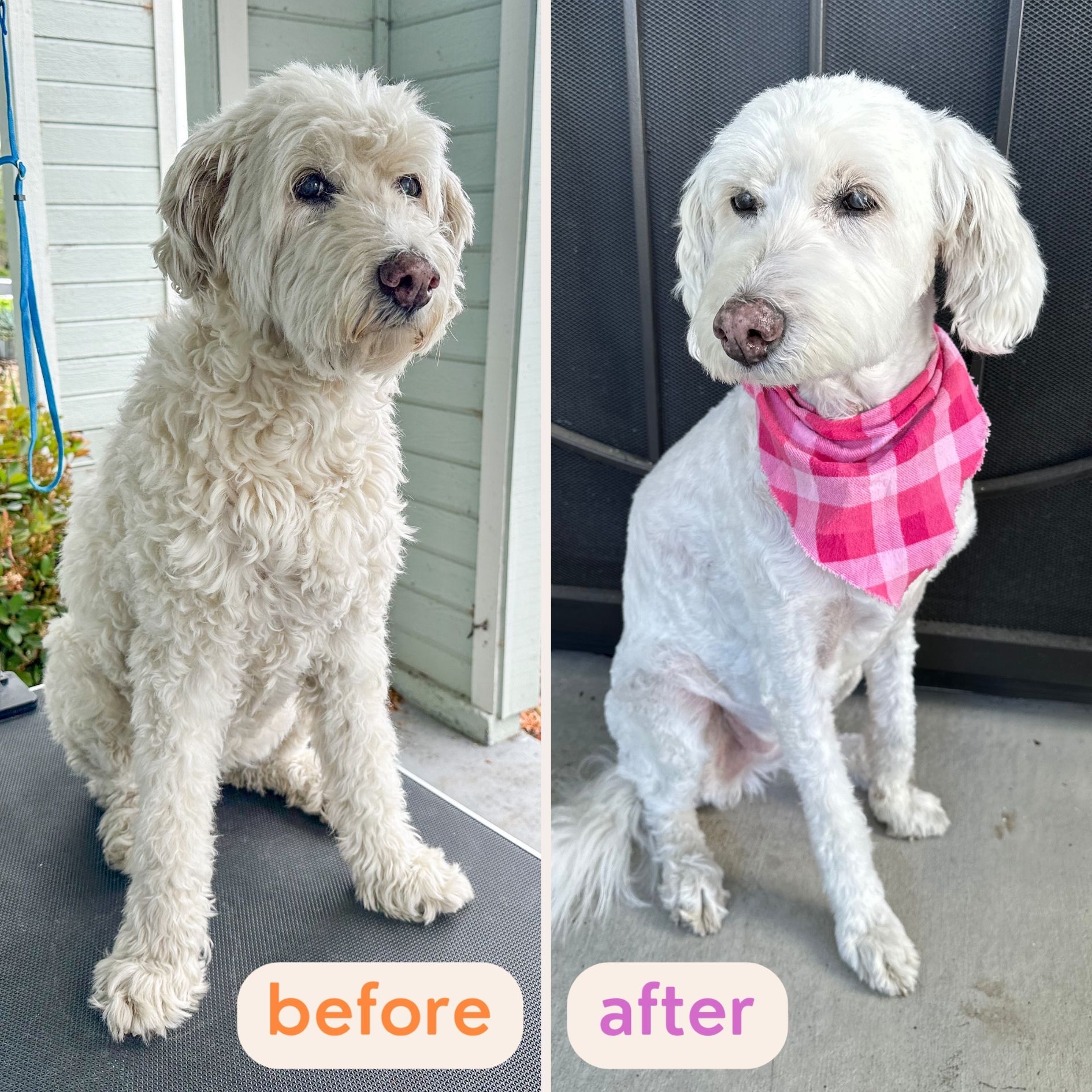
 “Every concern and question I had now has clear, practical solutions.” – Paula D.
“Every concern and question I had now has clear, practical solutions.” – Paula D.
 “These lessons have provided tremendous amounts of information.” – Steve B.
“These lessons have provided tremendous amounts of information.” – Steve B.
 “Buy the course and complain about how easy it is!” – Chris S.
“Buy the course and complain about how easy it is!” – Chris S.
Learn How To Groom Your Doodle At Home…
Safely…And Without Confusion:




